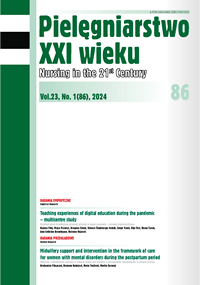Prevention of sudden unexpected postnatalcollapse (SUPC) of a newborn in relationto skin-to skin-contact
DOI:
https://doi.org/10.2478/pielxxiw-2024-0011Keywords:
newborn, skin-to-skin care, sudden unexpected postnatal collapse, midwives, neonatal nursesAbstract
PREVENTION OF SUDDEN UNEXPECTED POSTNATAL COLLAPSE (SUPC) OF A NEWBORN IN RELATION TO SKIN-TO SKIN-CONTACT
Aim. This study aimed to scoping review the existing literature on the Safe Utilization of Skin-to-Skin Contact (SSC) for neonates in the delivery room, focusing on interventions to enhance newborn safety and to prevent sudden unexpected postnatal collapse (SUPC).
Material and methods. A comprehensive scoping review in line with PRISMA-ScR guidelines was conducted, by searching for scholarly articles published between 2011 and 2022 in scientifi c databases like ScienceDirect, Web of Science, and PubMed.
Results. From an initial pool of 1,011 articles, relevant and topical ones were identifi ed and categorized into four thematic areas: Knowledge and Profi ciency of Delivery Room Nursing Staff; Use of Assessment Tools and Surveillance Strategies; Organizational Aspects of Delivery Rooms; Maternal Education and Active Participation.
Conclusions. To prevent SUPC-related issues, a holistic approach involving both clinical and mechanical monitoring is crucial, emphasizing maternal education and support from skilled nursing staff.
References
1. Jouza M, Macko J, Pecl J, et al. Nová diagnóza v neonatologii: náhlý neočekávaný postnatální kolpas. Pediatr. Praxi 2020; 21(2): 95-98.
2. Matzner R, et al. Prevalence and Components of Newborn Assessment Policies Related to Sudden Unexpected Postnatal Collapse. Nurs. Womens Health. 2020; 24(5): 344-350. DOI: 10.1016/j.nwh.2020.07.007.
3. Filippi L, et al. Incidence of Sudden Unexpected Postnatal Collapse in the Therapeutic Hypothermia Era. Am. J. Perinatol. 2017; 34(13): 1362-1367. DOI: 10.1055/s-0037¬1603678.
4. Fendrychová J. Prevence náhlého neočekávaného kolapsu novorozence. Pediatr. Praxi 2021; 22(|3): 237-239.
5. AWHONN. Sudden Unexpected Postnatal Collapse in Healthy Term Newborns: AWHONN Practice Brief Number 8. JOGNN. 2020; 49(4): 388-390. Doi: 10.1016/j.jogn.2020.05.002.
6. Ludington Hoe SM, Morgan K. Infant assessment and reduction of sudden unexpected postnatal collapse risk during skin to skin contact. New Inf. Nurs. Reviews. 2014; 14(1): 28-33.
7. Page MJ, et al. The PRISMA 2020 statement: an updated guideline for reporting systematic reviews. BMJ (Clinical research ed.). 2021; 372: n71. DOI: 10.1136/bmj.n71.
8. Červený M, Siaki L, Prosen M, et al. Challenges experienced by nurses caring for patients from different cultures: a scoping review of the literature, 2010-2020. Cent. Eur. J. Nurs. Midwifery. 2022; 13(4): 783-792. DOI: 10.15452/cejnm.2022.13.0024.
9. Hong QN, et al. The Mixed Methods Appraisal Tool (MMAT) version 2018 for information professionals and researchers. Education for Information. 2018; 34(4): 285-291.
10. Addison C, Ludington-Hoe S. Maternity Nurses’ Knowledge about Sudden Unexpected Postnatal Collapse and Safe Newborn Positioning. MCN Am. J. Matern. Child. Nurs. 2020; 45(2): 116-121. DOI: 10.1097/NMC.0000000000000597.
11. Ludington-Hoe SM, Morrison-Wilford BL, DiMarco M, et al. Promoting Newborn Safety Using the RAPPT Assessment and Considering Apgar Criteria: A Quality Improvement Project. Neonatal. Netw. 2018; 37(2): 85-95. DOI: 10.1891/0730¬0832.37.2.85.
12. Paul DA, Johnson D, Goldstein ND, et al. Development of a single-center quality bundle to prevent sudden unexpected postnatal collapse. J. Perinatol. 2019; 39(7): 1008-1013. DOI: 10.1038/s41372-019-0393-y.
13. Barbaglia M, Finale E, Noce S, et al. Skin-to-skin contact and delivery room practices: a longitudinal survey conducted in Piedmont and the Aosta Valley. Ital. J. Pediatr. 2019; 45(1): 95. DOI: 10.1186/s13052-019-0688-9.
14. Lavizzari A, Falgari R, Pesenti N, et al. Heart-rate agreement between ECG and a new, wireless device during early skin-to-skin contact. Acta Paediatr. 2021; 110(6): 1803¬1809. DOI: 10.1111/apa.15769.
15. Du Plessis J, Kirk M, Quilatan M, et al. Continuous pulse oximetry during skin-to-skin care: An Australian initiative to prevent sudden unexpected postnatal collapse. Acta Paediatr. 2021; 110(4): 1166-1170. DOI: 10.1111/apa.15552.
16. Davidson MR. Fast Facts for the Neonatal Nurse a Nursing Orientation and care Guide in Nutshell. Springer Publishing Company; 2014.
17. Roncati L, Piscioli F. Sudden unexpected post-natal collapse (SUPC) during skin-to¬skin care (SSC): where is the trouble?. Clin. Exp. Obstet. Gynecol. 2019; 46(5): 671¬673. DOI: 10.12891/ceog5081.2019.
18. Wada FH, et al. Bonding and Attachment Experience among Postnatal Mothers with Spontaneous Childbirth. Belitung Nursing Journal. 2020; 6(1): 14-20.
19. Chen L, Hsu T, Ou-Yang M, et al. Sudden Unexpected Postnatal Collapse of a Neonate During Skin-to-Skin Contact. J. Clin. Case Rep. 2016; 6: 898. DOI: 10.4172/2165¬7920.1000898.
20. Simpson KR. Emerging Trends in Perinatal Quality and Risk With Recommendations for Patient Safety. J. Perinal. Neonatal. Nurs. 2018; 32(1): 15-20. DOI:10.1097/JPN.0000000000000294.
21. Simon LV, Hashmi MF, Bragg BN. APGAR Score. [Updated 2023 May 22]. In: StatPearls [on-line]. Treasure Island (FL): StatPearls Publishing; 2023 Jan-. Available from: https://www.ncbi.nlm.nih.gov/books/NBK470569/.
22. Batey N, et al. The newborn delivery room of tomorrow: emerging and future Technologies. Paediatr. Res. 2020; 1-9. DOI: 10.1038/s41390-022-01988-y.
23. Feldman-Winter L, Goldsmith JP. AAP Committee On Fetus And Newborn, AAP Task Force On Sudden Infant Death Syndrome. Safe Sleep and Skin-to-Skin Care in the Neonatal Period for Healthy Term Newborns. Paediatrics. 2016; 138(3): e20161889.
24. Herlenius E, Kuhn P. Sudden Unexpected Postnatal Collapse of Newborn Infants: A Review of Cases, Definitions, Risks, and Preventive Measures. Transl. Stroke Res. 2013; 4: 236-247. DOI 10.1007/s12975-013-0255-4.
25. World Health Organisation. WHO recommendations on maternal and newborn care for a positive postnatal experience. https://www.who.int/publications/i/item/9789240045989.
Downloads
Published
Issue
Section
License
Copyright (c) 2024 Authors

This work is licensed under a Creative Commons Attribution 4.0 International License.




